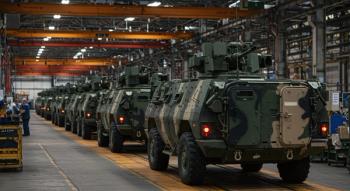
Technology Forum: Lasers and Optics
Joining us for this discussion are Lisa EO Mueller, Wavelength Electronics; Walter Burgess, Power Technology, Inc.; Rob Morris, Ocean Optics.
Lasers and optics continue to spur some of spectroscopy's hottest growth areas. With terahertz research emerging as a technique of the future, and with the continued popularity of LIBS and NIR research, lasers and optics will be the engines driving spectroscopy's future.
Joining us for this discussion are Lisa EO Mueller, Wavelength Electronics; Walter Burgess, Power Technology, Inc.; Rob Morris, Ocean Optics.
How will advances in laser technology make a difference in the average person’s life (i.e., the use of femto- and picosecond lasers)? Where will such advances show up in their everyday lives?
Mueller: Laser technology has been used primarily in communication, optical data storage (such as CDs and DVDs), and consumer electronics. The average person has been exposed to lasers primarily as entertainment and networking tools. The markets for laser technology are constantly expanding with biomedical equipment, scientific analysis instrumentation, and military/aerospace applications leading the way. Ultrafast lasers have enabled new applications in data storage capacity, network speed, plasma physics, ablation and deposition, nanomaterial creation, imaging, and detection.
Increasingly, the average person will find lasers in diagnostic, therapeutic and cosmetic medical treatments, such as blood composition analysis, tumor detection and vaporization, joint resurfacing and ligament repair, dental care, body shaping, skin treatment, and depilation. In addition, applications will include increased network speed and capacity, as well as public sector security, such as airborne contamination monitoring and explosives/narcotics detection. Handheld spectrometers are being designed to monitor agricultural products for composition and spoilage. They can also be used as breathalyzers for law enforcement or disease diagnosis. Forensic uses of lasers in crime scene analysis, DNA profiling/sequencing, and archaeological restoration are increasing. Lasers are also frequently used in recreation as laser sights, for night vision imaging, range finding, and holography.
Morris: The ability to design and manufacture faster lasers has implications for any application where greater peak power per pulse is desirable, such as medical imaging and the monitoring of very fast chemical reactions. In medical imaging, fluorescence techniques that rely on fast lasers for excitation can be useful in looking at cancer cells, proteins, and biological samples.
What do you think about the future of “ultrafast spectroscopy” in general? What role will laser sources play?
Mueller: Given human curiosity and “gee whiz” impulse – pushing the limits of what can be done – I think ultrafast spectroscopy will be a significant focus of future research and development. Recent experiments using subpicosecond lasers demonstrated the generation and detection of acoustic and shock waves in materials with terahertz frequencies. These very high frequency sound waves are useful for probing materials on very small length scales.
Other applications include OCT- optical coherence tomography (including industrial process control imaging), optical sampling, optical trapping of atoms for extended periods, optical tweezers, optical/semiconductor materials development, remote optical sensing, and pumping of mid-infrared optical parametric oscillators for high-resolution molecular spectroscopy.
As the range of laser sources available for ultrafast spectroscopy increases, the challenges of controlling those sources will also increase. Low noise drivers, stable temperature control in the operating range, and precision circuit response will always be necessary. Reducing cost and size is critical to seeing these systems become more mainstream.
Burgess: For the foreseeable future ultrafast lasers will have to stay on the factory floor or in the laboratory. The cost is still very high compared to an average laser (diode laser like that in printers, CD-ROM/DVD drives, and telecommunications applications).
Morris: For more than a decade of selling miniature fiber optic spectrometers, we have had customers asking for ultrafast spectrometers. Nearly all of that demand has been fueled by the emergence of faster, more powerful lasers. Coherent has a nice description of the use of ultrafast spectroscopy for monitoring gas phase reactions at
How much of a challenge/problem is vibration in laser and optical systems? Have there been any advances in vibration isolation recently?
Mueller: Vibration poses a serious challenge in analysis, imaging, machining, and automated control applications as it can distort the obtained results. As laser speed and power increase, the effects of vibration will likely become more problematic, rather than less.
Advances have been made in both mechanical stabilization and software algorithms for correction – particularly in imaging applications.
Burgess: From my company’s standpoint, vibration has not been a critical issue. Most manufacturers have engineering practices and procedures to limit the influences of vibrations. The newer ultrafast lasers are fiber based and would be more resistant to vibration than non-fiber based lasers.
Morris:Stability in laser systems is always an issue. Vibration can affect the laser beam profile and laser efficiency, and can be difficult to contend with. And anytime you add complexity to a technique or technology, it loses something in the process.
What are the biggest challenges manufacturers face in the area of optics?
Mueller:Optics is not my area of expertise, but I believe accurate beam profiling analysis options will help to optimize any desired spectral output. Profile shaping will have increasing importance as application-targeted, non-Gaussian profiles gain wider use, and to obtain true Gaussian output for highly precise instrumentation. In addition, the ability to achieve this with non-traditional materials, such as thin film polymers, is important as the use of lasers extends to a wider range of applications and operating environments.
Burgess:Talent. Businesses are built on people. Technology only plays a small part of a businesses technology. High-end technical people are difficult to locate and recruit. This also requires revenue that is hard to find in today’s economic climate.
Morris:Let’s focus on the U.S. market. Setting aside for a moment the challenges of contending with emerging competition and with making innovations become commercially viable in a timelier, less costly fashion, there’s the issue of who will become the next generation of optics artisans. As recently as November 2008, the Florida Photonics Cluster (FPC) identified a strong demand for skilled optics technicians, “but scarcely any capability in our nation’s colleges for preparing them.” The FPC supports government funding of The National Center for Optics and Photonics Education to begin a national project encouraging colleges to educate precision optics technicians (POTs).
The good news is, optical design engineering is quite robust and well served by America’s colleges and universities. So, we shouldn’t lack for ideas. But certainly there is a danger in losing the art that goes into the manufacture of precision optics if we were to outsource all our specialized work to China and elsewhere. That’s why investing in education now makes good sense. For more on this topic, I encourage readers to visit
What do you think?
Newsletter
Get essential updates on the latest spectroscopy technologies, regulatory standards, and best practices—subscribe today to Spectroscopy.




